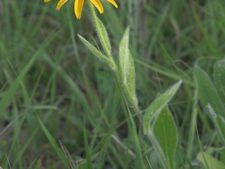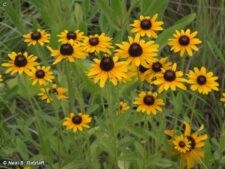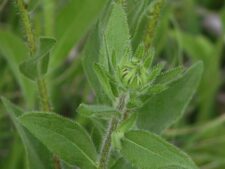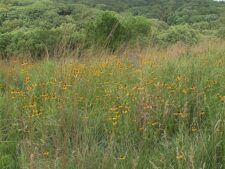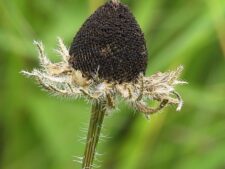
BLACK-EYED SUSAN
Rudbeckia hirta
SUNFLOWER FAMILY (Asteraceae)
 Identification
Identification
- Flowering time - June, July, August, September, October
- Common in prairies and open areas at FF and NW
- Yellow sunflower with cone-shaped, dark center
- Hairy leaves and stem - leaves not lobed
- See comments for comparison with other yellow sunflowers having cone-shaped or round centers
This native biennial or short-lived perennial typically grows to 1-2 feet tall, occasionally to 4 feet. The unbranched stem and leaves are covered with long whitish hairs (A,D). Their alternate, elliptical leaves have smooth, unlobed margins. Flowers are on long stalks each with a single head 2-3 inches wide (A,B). Each has 8-21 infertile, yellow, spreading, petal-like ray florets surrounding a rounded or cone-shaped disk of dark purple, fertile disk florets (A,C) which turn brown as they mature (F).
Grows in a wide variety of habitats, flowering mostly in June and July with occasional flowers as late as October. At Neale Woods, Black-eyed Susan is common in all prairie restorations. It is less common in sunny, open areas at Fontenelle Forest.
Other Rudbeckia species (“round or coneheads”) with spreading ray florets are Sweet Coneflower (Rudbeckia subtomentosa), a taller plant that does not have prominent white stem or leaf hairs, and Brown-Eyed Susan (Rudbeckia triloba) a much branched species with abundant, but much smaller flower heads. Also, these two plants often (not always) have at least a few leaves that are deeply lobed.
Other common names include Brown Betty, Brown Daisy and Donkeyhead.
The content of NatureSearch is provided by dedicated volunteer Naturalists of Fontenelle Forest who strive to provide the most accurate information available. Contributors of the images retain their copyrights. The point of contact for this page is: Roland Barth.

